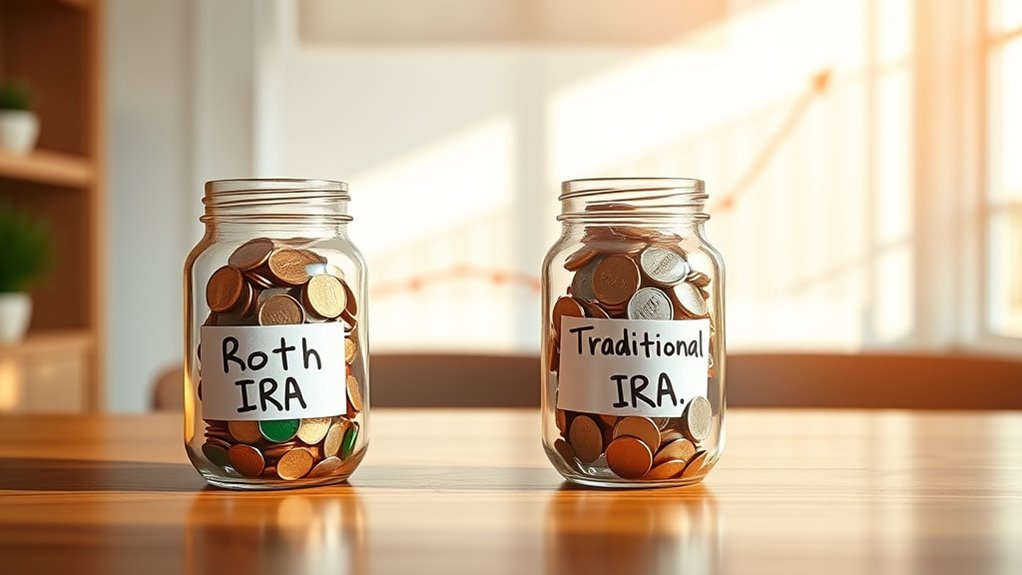If you expect your tax rate to be higher in retirement, a Roth IRA could save you more in taxes over 30 years because it offers tax-free growth and withdrawals. If you think you’ll be in a lower tax bracket, a Traditional IRA may provide immediate tax benefits now. Your choice depends on your current income, future income expectations, and tax rate forecasts. Keep exploring to discover which option suits your long-term savings goals best.
Key Takeaways
- Roth IRA offers tax-free growth and withdrawals, potentially saving more on taxes over 30 years if tax rates increase.
- Traditional IRA provides an immediate tax deduction, reducing taxable income now, but taxes are paid upon withdrawal.
- If you expect higher tax rates in retirement, Roth IRA generally results in greater long-term tax savings.
- Traditional IRA is advantageous if you anticipate lower tax rates in retirement, minimizing future tax liability.
- The optimal choice depends on current vs. future tax rates, investment growth, and personal financial projections.

When planning for retirement, choosing between a Roth IRA and a Traditional IRA is an essential decision that can impact your financial future. One of your primary considerations should be how each account affects your investment growth and the tax implications you’ll face over time. Understanding these differences helps you make smarter choices that could save you thousands of dollars over the long haul.
Choosing between a Roth IRA and a Traditional IRA can significantly impact your long-term retirement savings.
A Traditional IRA allows you to contribute pre-tax dollars, which means you get an immediate tax deduction. This reduces your taxable income for the year you make the contribution, giving you a quick tax benefit. The money then grows tax-deferred, meaning you won’t owe taxes on the gains until you withdraw it during retirement. This setup can accelerate your investment growth because more of your money is working for you without the drag of annual taxes. However, when you start taking distributions, those withdrawals are taxed as ordinary income, which could be at a higher rate if your income increases in retirement.
In contrast, a Roth IRA is funded with after-tax dollars. You don’t get an upfront deduction, but the investment grows tax-free, and qualified withdrawals are also tax-free. Over a span of 30 years, this can be a significant advantage. Since you won’t owe taxes on the investment gains when you withdraw, your money can compound without interruption from tax payments. This means the growth potential of your investments could be much higher in the long run, especially if your investments perform well. The tax implications favor those who anticipate being in the same or a higher tax bracket during retirement, as they’ll benefit from tax-free growth and withdrawals. Additionally, the ability of certain tax-advantaged accounts to maximize long-term growth can play a crucial role in your retirement planning.
Deciding which account saves you more taxes over three decades hinges on your current versus future tax rate, your income level, and your investment strategy. If you expect your tax rate to be higher in retirement, a Roth IRA might save you more in the long run because you pay taxes now at a lower rate and enjoy tax-free growth and withdrawals later. Conversely, if you believe your tax rate will be lower in retirement, a Traditional IRA could be more advantageous, allowing you to enjoy the immediate tax deduction and defer taxes until you withdraw.
Ultimately, your choice depends on your current financial situation, your expectations about future income, and your retirement goals. Both accounts offer unique benefits that influence investment growth and tax implications, so understanding these differences helps you maximize your savings and secure a more comfortable retirement.
Frequently Asked Questions
Can I Convert a Traditional IRA to a Roth IRA Later?
Yes, you can convert a Traditional IRA to a Roth IRA later. This conversion strategy involves transferring funds, but be aware of the tax implications—you’re required to pay taxes on pre-tax contributions and earnings. Timing matters, so consider your current income and future tax outlook to optimize benefits. Planning ahead helps you navigate the conversion process smoothly and maximize your long-term savings potential.
Which IRA Has More Investment Options?
When comparing IRAs, you’ll find that a traditional IRA often offers more investment diversity and account flexibility. You can choose from a wider range of assets like stocks, bonds, and mutual funds. Roth IRAs typically have similar options but might be slightly more limited depending on the provider. If you want maximum investment diversity and flexibility, a traditional IRA might better suit your needs, allowing you to tailor your portfolio more easily.
Are There Income Limits for Roth IRA Contributions?
Think of income limits as the gates to your financial garden. If your income exceeds certain thresholds, you might face contribution restrictions for a Roth IRA. Specifically, high earners are phased out from contributing directly, so they need to explore other options. These income limits are set to keep the Roth accessible to many, but they do tighten the contribution restrictions for those with higher income levels.
How Does Early Withdrawal Affect Taxes?
When you make an early withdrawal from your IRA, you face penalty implications and possible tax consequences. If you withdraw before age 59½, you usually owe a 10% penalty plus taxes on the amount, unless it qualifies for an exception. The tax calculation depends on whether your account is Roth or Traditional. Understanding these rules helps you avoid surprises and plan withdrawals wisely to minimize penalties and tax impacts.
Can I Have Both Roth and Traditional IRAS Simultaneously?
You can definitely have both Roth and Traditional IRAs simultaneously, which is a smart move for retirement planning. This allows you to benefit from tax diversification, giving you flexibility in managing your withdrawals and taxes in retirement. Having both accounts lets you hedge against future tax changes and optimize your savings strategy, ensuring you’re better prepared for a secure financial future. Just be mindful of contribution limits to stay compliant.
Conclusion
Choosing between a Roth and a Traditional IRA is like picking your path through a forest—you might not see the full view now, but your decision shapes your financial landscape for years to come. If you value tax-free growth and flexibility, a Roth can be your guiding star. But if upfront deductions matter most, Traditional might be your best bet. Whichever you choose, taking action today is the key to planting the seeds for a more secure tomorrow.









